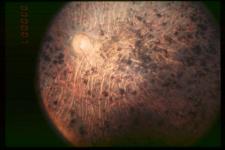Texas Woman Is the First Person to Undergo Optogenetic Therapy
By Katherine Bourzac,
MIT Technology Review
| 03. 18. 2016
Untitled Document
A blind woman in Texas is the first person to undergo therapy based on an emerging technology called optogenetics. If successful, the therapy will create light-sensing cells in one of her eyes and enable her to see again.
This patient and others being recruited for a clinical trial have a degenerative disease called retinitis pigmentosa. In this disease, the light-sensitive cells of the retina gradually die off. These cells pass electrical signals on to nerves that convey them to the brain.
The therapy uses optogenetics, a technology that uses a combination of gene therapy and light to precisely control nerves. The therapy should make certain nerve cells in the woman’s eye, called ganglion cells, light-sensitive. The eye was injected with viruses carrying DNA from light-sensitive algae. If it works, the cells will do what the healthy retina’s cones and rods do: fire off an electrical signal in response to light, restoring some vision.
Read more...
Image via Wikimedia
Related Articles
By Grace Won, KQED [with CGS' Katie Hasson] | 12.02.2025
In the U.S., it’s illegal to edit genes in human embryos with the intention of creating a genetically engineered baby. But according to the Wall Street Journal, Bay Area startups are focused on just that. It wouldn’t be the first...
By Emma Cieslik, Ms. Magazine | 11.20.2025
Several recent Biopolitical Times posts (1, 2, 3, 4) have called attention to the alarmingly rapid commercialization of “designer baby” technologies: polygenic embryo screening (especially its use to purportedly screen for traits like intelligence), in vitro gametogenesis (lab-made eggs and sperm), and heritable genome editing (also termed embryo editing or reproductive gene editing). Those three, together with artificial wombs, have been dubbed the “Gattaca stack” by Brian Armstrong, CEO of the cryptocurrency company...
By Adam Feuerstein, Stat | 11.20.2025
The Food and Drug Administration was more than likely correct to reject Biohaven Pharmaceuticals’ treatment for spinocerebellar ataxia, a rare and debilitating neurodegenerative disease. At the very least, the decision announced Tuesday night was not a surprise to anyone paying attention. Approval...




